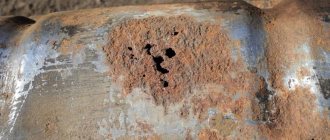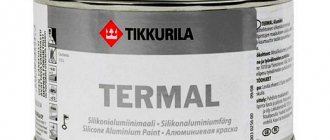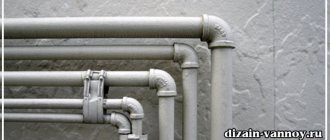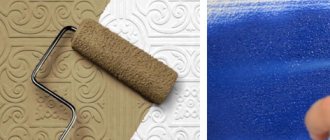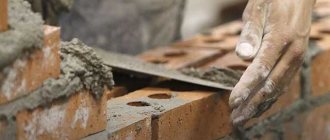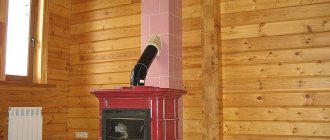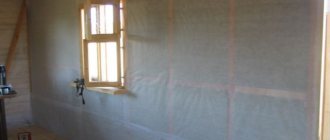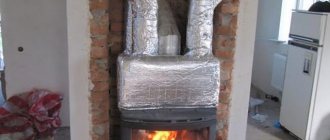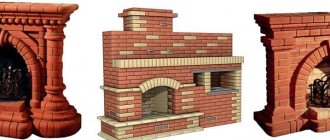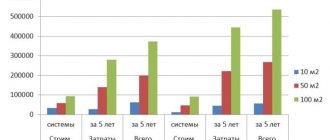General recommendations
- When choosing any paint, be wise:
- specify the composition and purpose (what can be used to paint a potbelly stove in a carpentry workshop may not be acceptable for an iron bathhouse or home brick stove);
- find out the availability of certificates (unfortunately, there are dubious products on the market made from ingredients that have not been tested for safety. Certificates largely eliminate this issue and inspire confidence in the manufacturer);
- do not forget to use the product correctly - prepare the base (clean it of dust, grease, debris) and apply the required number of layers.
Caution and rationalism in finding solutions will help you achieve your goal without harm to your health, beautifully paint your stove or fireplace, and protect the outside from damage.
Factors that negatively affect paint
The main problem that arises when choosing a coating is the high surface temperature. Therefore, standard options for solving this issue are not suitable. Ordinary paints will not withstand use on metal heated to three hundred degrees; they will simply peel off or burn. But this is not the only thing you need to think about when choosing a composition. There are other conditions, namely:
- Any metal tends to expand as it heats up. The material for furnaces is selected in such a way that this indicator is minimal, but it is still impossible to reduce it to zero. Therefore, there is a significant risk of paint cracking during use.
- During its intended use, a considerable amount of steam is generated in the bathhouse. High humidity causes the coating to peel off, so this factor must be taken into account when choosing the type of paint.
How to paint a brick stove in a house - video instructions for painting with your own hands and photos
Many people are interested in how to paint a brick stove in a house, because old and tarnished masonry does not always fit harmoniously into the interior of a kitchen or room.
We will tell you how to paint a brick oven and how best to do it yourself.
How to paint a brick stove - there are several options.
Peculiarities
The photo shows what the painted stove looks like.
The operation of furnace equipment occurs at elevated and extreme temperatures, and this imposes a number of specific requirements on finishing materials:
- The coating must consist of refractory, non-flammable components that retain their properties at high temperatures;
- The finish must withstand significant temperature changes, because the difference between the heated and cold surface of the oven can be very significant;
- The material from which the stove is made undergoes noticeable thermal expansion during its operation, so the finishing coating must be sufficiently elastic to neutralize these changes in the geometry of the structure;
- The surface of the coating should radiate heat well. It is known that radiation in the infrared frequency range occurs most actively with dark colors; moreover, matte and rough surfaces transfer heat better;
- The paint or varnish should not contain components that, when heated, will release harmful compounds and toxins into the atmosphere. Solvents contained in heat-resistant enamels must quickly and completely evaporate, and paints must be prepared on the basis of water or non-toxic solvents;
- Coatings for metal parts must withstand high temperatures - from 600 degrees and above.
A special operating mode imposes specific requirements.
Important! The purpose of the finish differs. If walls and facades need to be protected from moisture, solar radiation and biological corrosion, then the stove coating is applied for decorative purposes and for the convenience of cleaning the surface from dust and ash
If walls and facades need to be protected from moisture, solar radiation and biological corrosion, then the stove coating is applied for decorative purposes and for the convenience of cleaning the surface from dust and ash.
Applying varnish to the stove
Choose a heat-resistant varnish.
For those who want to open their stove with varnish, we have compiled step-by-step instructions:
- Before painting a brick stove, it must be prepared: cleaned of dust and dirt, putty on cracks and chips, and repaired flaws. To do this, you can mix brick flour with egg white and milk and apply it to the surface of a warm oven with a brush in places where the surface is damaged;
We clean and repair the stove surface.
- After the repair compounds have dried, open the jar of varnish and mix its contents thoroughly. If the material is too thick, dilute it with solvent 646 or turpentine to the desired thickness (like paint);
Open and mix the varnish; if necessary, dilute with solvent.
- Apply the varnish with a hard bristle brush. The first layer should fill all the pores and irregularities, after it dries, apply a second layer, which will level the surface, and then complete the process by applying the finishing third layer;
Carefully apply the varnish to the surface in three layers.
- We paint metal parts from a can with fireproof paint or enamel. Before applying the coating, the products should be thoroughly washed and degreased with alcohol or solvent.
We paint metal parts.
Important! Before applying paint, the surface boundaries should be edged with masking tape so that you do not have to clean off stains from everything around the area to be painted.
Surface preparation
First of all, you need to take care of preparing the stove surface. Before starting work, it is recommended to inspect the stove or fireplace. New brickwork does not require any special preparation other than cleaning it from dust. What paint to paint a wooden chair with your own hands? If the stove was plastered earlier, then you need to find out how thick the layer is.
With a thickness of more than 1 cm, heat transfer decreases sharply. This plaster needs to be dismantled. When we are not talking about complete removal, only crumbling areas are scraped off. The entire surface of the stove is thoroughly cleaned.
Cracks and sanded areas are rubbed with a lime-gypsum or lime-clay composition.
It is not always necessary to remove old paint. If it is not badly damaged, then it is enough to wipe off the dirt and dust. Then you can cover with a fresh layer. But first you need to find out what kind of coating was applied. The newly applied layer must match the old one.
For example, chalk paint will not adhere to lime whitewash; it will simply crumble. And vice versa. If you don’t know for sure, then it’s better to scrape everything down to the brick.
Before painting the stove, remove dust with a damp cloth. Then let the surface dry thoroughly.
There are no special tricks in how to paint a brick stove. Any untrained person can do this. Diluted or ready-made paints are simply applied with a brush in two or more layers. Painting a plastered stove is carried out only after the preparatory work has been completed, otherwise it will be ineffective.
And it will have to be repeated after a very short period of time.
How to cover a brick oven in general? The following methods can be distinguished:
- painting;
- plaster;
- varnish coating;
- laying with heat-resistant ceramic tiles or tiles.
Now let's take a closer look at how to paint a brick stove. Not every paint is suitable for this. It must meet certain characteristics.
Good heat-resistant paint protects brickwork from aggressive environments and moisture. Here are some of the most common staining methods for brick:
- lime whitening;
- chalk painting;
- coating with homemade paint;
- painting with modern materials.
Why do you need to paint?
The main task of paint is to protect the surface from rust. No matter how high-quality the material from which the sauna stove was made, the consequences of negative influences may appear over time. The hot water tank is most at risk of rust, and due to the fact that it forms from the inside, it is quite difficult to avoid.
The second reason why a sauna stove needs to be painted is the aesthetic component. An object made entirely of metal is difficult to fit harmoniously into the overall picture of the room. Some finished products are sold already painted, otherwise you will need to do it yourself.
Coloring instructions
Having learned how to paint the stove in the bathhouse, you can purchase paint and prepare the stove for painting.
Tools and materials
To do the work yourself you will need:
- paint, preferably in aerosol cans;
- if you use liquid paint in cans, you will need to purchase a roller and brush;
- sandpaper to remove a layer of rust;
- metal brush;
- when cleaning large areas, use a grinder;
- solvent for degreasing parts;
- for painting you can use a spray gun and a compressor, especially with large dimensions of the structure;
- rags;
- paper or old sheets to protect the surface of walls and floors when painting.
Having dealt with the question of how to paint an iron stove in a bathhouse and having prepared the materials necessary for the work, you can begin to carry out the preparatory work.
Surface preparation
To do this you will need to perform a number of simple works. But surface preparation must be approached with full responsibility; this determines how the paint will adhere to the metal and how long its layer will withstand high temperatures:
- Using a metal brush, we clean the stove from adhering dirt, soot and rust;
- Clean the finished surfaces with fine sandpaper. This work will make the surface smooth, remove minor scratches and irregularities;
- sweep and remove dust from the stove parts;
- Having generously moistened a rag with solvent, degrease all surfaces;
- If the stove has parts made of stainless steel or those that have undergone galvanic treatment, there is no need to paint them. Therefore, we will apply a layer of grease or other lubricant to the parts;
- cover the surface of the floor and walls next to the heater, paper or cloth.
Paint application algorithm
We know how to paint an iron stove in a bathhouse, the necessary preparatory operations have been completed, now you can move on to the main stage of work. This will not require much time and effort. All work is carried out in the following sequence;
- open and stir the paint well. If it is thick, it can be diluted with a solvent suitable for this enamel. Be sure to read the instructions and dilute the paint only with the specified mixtures. Otherwise, you'll just throw away a can of expensive paint;
- if a spray gun is used to apply the layer, the paint is diluted to a more liquid state, then poured into the spray gun through a painting sieve or the wife’s old tights;
- first apply a layer to all inconvenient places and edges of the oven and only then treat the surfaces, slightly overlapping the previous layer. When painting with a brush, the work is done in the same way;
- The paint is applied in 1 layer, so do not allow any gaps, painting all surfaces evenly.
Work is done. Now leave the oven until the enamel has completely hardened.
It is important to close all doors and windows to prevent dust from entering the room. For some paints you will need to light the oven; they only harden when heated.
Therefore, carefully read the instructions and strictly follow these rules.
How often should I paint in the future?
Paint for an iron sauna stove will last for the period specified by the manufacturer
You need to pay attention to this characteristic when purchasing enamel.
In any case, if the stove is made of thin metal, it may fail before the paint coating of the surfaces. Paint is a short-lived coating, so every bathhouse owner should be prepared for repeated work to protect the stove.
Is it possible to achieve a durable protective layer on the surfaces of the heater? Yes, in this case, performing a simple galvanic method of protecting the metal will help.
Types of paints and their differences from each other
You can use different paints to apply a protective coating:
- water-based acrylic;
- organosilicon;
- polyurethane.
Water-based acrylic painting material is very convenient and affordable. The downside is that it can only be used for stoves located in rooms with low humidity, so this option is not suitable for saunas.
Photo 1. A jar of white water-based acrylic paint. .
Polyurethane paints are more heat-resistant and can withstand heat up to 600 degrees, it all depends on the constituent elements and additives in the paint. Study the composition in detail
Please note that polyurethane mixtures may change color when heated.
Organosilicon paint and varnish enamels are considered the most environmentally friendly and durable. They are able to withstand temperatures up to 800 degrees. There are no toxic substances in the composition, so their use is safe. The only downside is the high cost.
Types of paints
Leaving the stove structure in its natural, unprocessed form is not the best solution. If you do not want to hide the brick surface, then it is enough to cover it with colorless paint. This event will not hide the relief of the walls, but will protect the coating from negative factors and make the overall appearance attractive. To understand how to paint a brick stove in a house, you need to learn more about the options for dyes and their compositions.
Types of paintwork:
- Water-based acrylic substances . They have a budget price and are easy to apply with a regular brush or roller. The only drawback of this paint is that it is afraid of humidity, so it is not advisable to use it where this indicator is high.
- Polyurethane . They are famous for their heat resistance. Their heating limit is up to 600 degrees, but a side effect is possible. Some polyurethane paints may discolour slightly.
Stove painted with polyurethane composition Source www.remontnik.ru
- Organosilicon enamels . Unlike previous types, they are more expensive in price, but have many advantages. They can withstand temperatures up to 800 degrees, are made from environmentally friendly materials, have an increased durability, and do not contain toxic substances. During operation, economical consumption is observed.
- Substances based on lime and chalk . Not suitable for red brick, they are inexpensive, penetrate well into stone, have an antifungal effect and are easy to apply.
Disadvantages of lime products:
- Requires multiple applications.
- Touch-up is required (at least once every two years).
- There is a risk of incorrectly calculating the consistency.
- The brick wall must first be treated with water-based paint or plastered, which means additional costs and time.
If the owner of the house decides to start processing and does not know how to paint the brick stove in the house, it is better to give preference to silicone enamel. It will not cause harm to residents, will ensure the safety of the brick, and will create a presentable appearance of the stove structure.
Practical use of colorless silicone enamel for ovens Source istopnik.su
See also: Catalog of companies that specialize in paints and varnishes.
Lime and chalk
These two solutions are often practiced when the question arises: how to paint a brick oven.
The key word here is “brick”. The choice of coloring matter will also be appropriate. The paint must have good penetration. Further differences will affect the room in which the object is located. If in a bathhouse, then the relevance of moisture resistance and invulnerability to steam increases; if in a living room, beauty is important; in garages and industrial premises, strength is important. Stoves in garages and other non-residential premises are often subject to mechanical stress - accidental impacts from handling tools, etc. Accordingly, the paint layer must adhere as tightly as possible.
Perhaps these are the most ancient and life-tested methods.
- Advantages:
- financial inclusion;
- ease of preparation of the composition;
- ease of application;
- antifungal effect (in the presence of lime).
the need for multiple applications (otherwise the transparency of the top light layer against the background of the dark bottom layer is guaranteed);
Lime and chalk are absolutely not suitable for painting red brick stoves. In the absence of experience, it is quite difficult not to make a mistake with the consistency;
- zero moisture resistance (accordingly, such solutions are unacceptable for sauna stoves);
- Both lime and chalk are problematic to apply to old water-based layers. But applying the solution after plastering is an ideal option.
Useful tips from the experts
- Experts recommend:
- Focus on the thickness of thick kefir or liquid sour cream. This mixture will not spread during application;
- add 30-40 g of salt, previously dissolved in warm water. This will increase the strength of the applied mixture;
- Before starting work, if possible, remove old chalk and lime layers, thoroughly wet the base with water using a spray bottle or a wide soft brush;
- for painting, use brushes only with natural bristles, and in some cases you can use a foam roller or short-pile fur roller;
- Apply each subsequent layer on top of the previous one only after it has dried.
As for the number of layers, there should be 2-3 layers in total. Primary, main and fixing.
What are the reasons for working?
Can it be applied to brick, metal, enamel? As a rule, lime and chalk are used for painting brick substrates. For example, if you need to renovate a Russian stove in a residential building or a brick or stone structure in a country house.
Iron is sometimes also coated with lime (almost never with chalk), but the result quickly disappears - the coating literally comes off in patches within a few months after the work has been completed. It is best to work on iron substrates with special paints.
Neither lime nor chalk are categorically compatible with enameled bases - the applied solution is repelled by a too dense smooth base.
Lime and chalk whitewash
If the question arises about how to paint a brick oven, then the first thing that comes to mind is to whitewash it. The most famous and common method. From time immemorial, our ancestors used this method.
Whitewashing is done with slaked lime - a mixture of lime powder and water. To improve the quality of the paint, salt and drying oil are added to the solution. Has a number of advantages:
- low cost;
- undoubted bactericidal properties;
- resistance to temperature changes;
- moisture resistance;
- good adhesion to the surface to be coated;
- good hiding power.
Care should be taken when working with lime. Since it is alkali, there is a possibility of getting burned. The stove is painted in two layers.
Moreover, the second layer is applied to the first one that has not yet dried.
Chalk paint is a suspension of crushed chalk in water, with the addition of gelatin or wood glue. It is applied in several layers, with the only difference being that each subsequent coating layer must be applied to an already dry surface. Otherwise you will get streaks and stains. The advantages of chalk paint for a brick kiln include the following:
- more than affordable price;
- safety at work;
- environmental friendliness;
- pure, crystal white color.
The biggest disadvantage of chalk whitewash is its easy washability. What paint should I use to paint the plastic on a scooter? That is, it is necessary to repeat this procedure quite often.
To add whiteness, blue is added to both solutions.
Sometimes whitening is used with tooth powder. The powder is mixed with egg whites and milk. The coloring composition is applied to a well-heated oven so that the proteins “set.”
The result is a coating similar to paint, which does not get dirty and is easy to clean.
What kind of stove
So, some are looking for how to paint a stove in a metal bathhouse, while others are interested in how to paint a brick stove - we have answers to both questions.
Made of metal
Metal stoves for bath procedures are made of either steel or cast iron.
Both circumstances are not particularly significant when choosing paint - it is much more important that the paint is particularly heat-resistant, because it will have to withstand the temperatures of a hot stove. On sale you can find paints with different temperature limits, which are formally expressed in its definition:
Heat resistance is a word that defines the relationship of paint to temperatures up to 600 degrees. However, you can find a clearer definition on the label - there are paints that can withstand up to 200 degrees (they are useful for painting heating radiators, not your stove).
BY THE WAY! There are heat-resistant varnishes, the limit of which is around 250-300 degrees - also not an option for a stove, but they can be useful in its environment.
Heat resistance is a loose concept, but this is the name given to paints that can withstand the temperature we need above 600 degrees. Their upper limit is somewhere around 1000 degrees. It is this category that comes in handy when you need to paint the outside of a metal stove in a bathhouse(!).
Because inside it is better to use paints that are called “fireproof”, which means the following: they are not afraid of contact with open fire.
IMPORTANT! Don't confuse "fire resistance" with "fire protection". There are paints that protect the surface they cover, inflating like a pillow and preventing fire from reaching this surface, at the same time depriving it of oxygen supply
Do not cover the stove with them))).
So, to summarize: you can paint an iron stove in a bathhouse on the outside with heat-resistant paint and on the inside with fireproof paint.
All that remains is to choose the application method, taking into account that by choosing a brush, you slightly increase the amount of paint consumed (compared to a spray bottle, for example), but you benefit in price if you compare it with the price of paint in spray cans. Heat-resistant paint can be applied as usual - with a brush, spray gun, roller or spray can.
Heat-resistant paint can be applied as usual - using a brush, spray gun, roller or spray can.
Brick
The question of painting bricks does not arise very often. Previously, stoves were either left as is or painted with lime, but more often they were plastered brick stoves.
In general, stoves were plastered not just to make them more beautiful, but to ensure that the brickwork did not lose its integrity, because over time, all these temperature changes during kindling in the cold, for example, affect the masonry - it cracks, becomes painted, and opens up smoke into the room.
Therefore, the stove was plastered and covered with lime so that the cracks, which were blackened by the smoke, could be immediately seen.
Nowadays, this is more often done with chimneys, and sauna stoves are preferred to be left “in their natural state” - with bare brick. But there are also designers who paint bricks in different colors, using modern paints - this is another way to make the interior more attractive.
So, you can either whitewash the stove with lime or chalk, or paint it with the same heat-resistant paint. And as an example, we’ll show you a video where a stove was painted red and gray using CERTA:
But this, by the way, is a question: is it worth taking paint with a limit of 750 if such temperatures do not occur close to such temperatures on the surface of the brick? After all, the higher the limit, the more expensive the paint - you could have gotten by with heat-resistant ones...
Why painting is needed
Paint protects the stove from fungus and mold.
The interior decoration of the home should be ergonomic, presentable and efficient. This applies to every element of the environment, otherwise the desired result cannot be achieved.
The decision to paint a brick stove in a house is based on the following reasons:
- Aesthetic component. Correctly selected paint will camouflage red brick well and allow you to achieve an ideal combination with furniture and decoration.
- Accuracy. Applying paint makes the surface monochromatic and allows you to cover up the characteristic masonry pattern in the form of a lattice, which not everyone likes.
- Saving time, effort and money. If you paint a brick stove in a wooden house with high quality, you do not need to plaster it first.
- Increased security. The solution fills all cracks and cracks, preventing the growth and appearance of new similar defects.
After hardening, the plaster solution acquires thermal insulation properties. This will increase the heating time of the walls and reduce the overall heat capacity.
Types of paints
Materials for painting stoves
The retail chain offers a wide range of paint and varnish coatings that can be used to paint a brick stove in a house without plastering.
- Enamel. It is distinguished by layer density, strength and shiny surface. Looks good, easy to clean, but tends to crack.
- Oily. It is considered the best option for interior painting. The compositions apply well, lie evenly and smoothly. Resistant to high temperatures, have high protective properties. The disadvantages are that it takes a long time to dry and the unpleasant smell in the room persists for a long time.
- Heat-resistant varnish. The substance has a positive effect on the strength of the outer layer of the walls. The work uses colorless and powder-pigmented brands of compositions. Smooth gloss looks impressive, but requires careful handling.
- Drying oil. A time-tested product with antiseptic, strengthening and decorative properties. The solution is inexpensive, retains the color and texture of red brick, with a slight darkening of the shade. The surface remains viscous, and therefore it should be varnished.
To paint a brick stove, you can come up with ideas yourself, ask friends, or look at finished works. There are no rules in this regard, only your own priorities.
Criterias of choice
The color is chosen that matches the interior.
The criteria on this issue are as follows:
- financially rising cost;
- smooth texture on which dirt and dust will not accumulate;
- color suitable for the interior;
- matching furniture and decoration;
- absence of excessive variegation;
- possibility of applying it yourself.
As a rule, there are no problems with the choice and coloring process.
Requirements for oven paint compositions
Choose heat-resistant paint
In addition to purely aesthetic properties, products for lining brick ovens must have certain technical characteristics:
- resistance to temperature changes;
- immunity to extreme heat;
- resistance to moisture and detergents;
- long service life;
- quick drying;
- absence of unpleasant odors;
- environmental cleanliness;
- Fire safety;
- color preservation.
Manufacturers indicate step-by-step instructions on the rules for using the material on the packaging. This information should be carefully studied when purchasing and before using the solution.
Which one is better to use?
How to paint a metal stove in a bathhouse? To do this, it is necessary to buy heat-resistant or organosilicon enamels, varnishes that can withstand heating up to 6000. The layer must maintain its solidity and prevent the formation of rust on the structural steel from which inexpensive bath “units” are made.
As a rule, dark colors are used, even black. It increases the heat transfer level of the furnace. Aluminum based paint is not recommended. The most in demand are organosilicon enamels from Russian and foreign manufacturers. It contains:
- organic resin;
- aluminum powder;
- organic radicals;
- silicon base and oxygen.
Now let's look at specific brands:
- The leader among domestic brands is Cetra. Available for different heating temperatures. Black enamel can withstand heating temperatures up to 9000.
- Another heat-resistant paint, produced in cans and having good properties at a low price, is heat-resistant enamel of the Kudo brand.
- Among foreign manufacturers, we can highlight the Finnish “Thermal” from.
How to paint a metal stove in a bathhouse from the inside? For this it is better to use fireproof paint. Its only disadvantage is its high price.
Painting a brick oven correctly
Sometimes there is a need to update the appearance of a brick-lined stove. What to do here, how to paint a brick stove in a country house or in a bathhouse, provided that the finishing work will be done with your own hands.
If you have a question about how to paint a red brick stove, we will try to help you.
You can successfully use lime whitewash with the thickness of liquid sour cream. But there are also special paints designed for painting brick.
Painted brick
Before you start painting the stove in the bathhouse with your own hands, be sure to read the instructions; there are paints for interior and façade bricks. But in our case, there is a more complex question - how to paint a brick stove so that later during operation the paint does not change its color and does not peel off?
Paints and methods of application
Before purchasing paint, be sure to check that it is heat-resistant. Silicon-organic enamel is suitable; it can withstand temperatures of about +600°C. The following brands of silicon-organic paints are available for sale:
- KO-168
- KO-174
- KO-813
- KO-835A
- KO-1112
To dissolve these enamels, you can use turpentine or solvent 646. To obtain a good result, the paint must be applied in 2 - 3 approaches in as thin a layer as possible. This will prevent the formation of smudges.
Paint for bricks - we prepare it ourselves
If there is no suitable paint available, you can make it yourself. To do this you will need PF-283 varnish and turpentine. The ingredients are mixed in 1:1 proportions and stir well.
The resulting mixture is transparent with a slight haze. To get the color you require, proceed as follows:
- Take gouache of the required color and dry it well.
- Dry gouache is ground to form a fine powder.
- Dry gouache powder is added to the varnish and turpentine mixture until the desired shade is obtained. Can be painted.
Painting the stove surface
Before painting the stove, you should make sure whether it needs to be restored? Restoring the surface of the stove with your own hands will not take much effort and time, but will protect it from cracks, damage and the negative effects of time.
Recommendations for performing the work:
- The outer part of the warm oven is treated with a brush with a special environmentally friendly varnish that is resistant to prolonged high temperatures and mechanical damage. To do this, you can use a mixture - varnish, prepared by yourself. Make a mixture of flour obtained from tap bricks, milk and 10 egg whites. It should be thick and viscous, then the surface will be a uniform red color.
- To give the surface a dark red matte hue, you can apply drying oil.
- If you want to get a shiny effect, you can coat the stove with oil or synthetic varnish.
- Shades of latex coloring composition will help satisfy color preferences.
A mixture of turpentine and varnish PF-283 can also be used as paint for the stove. Taking equal proportions of these substances, a transparent, slightly matte substance is obtained. It can be given the desired color. To do this, the dried gouache, ground into powder, is first carefully sifted, then added to the mixture, achieving the desired result.
Types of paints
As already noted, not every paint will withstand the test of a hot surface and high humidity. Therefore, when intending to paint the stove and water tank, you should be very careful when choosing a paint composition. Special products are based on silicone or other substances containing silicon. With sufficient heating (up to approximately +150°C), polymerization occurs, as a result of which the paint fuses into a durable film that can withstand all types of external influences and prevent rust. The most well-known compositions include the following types:
Advantages of paint KO-8101
- Paint KO-8101. The most affordable option, guaranteeing a service life of up to 15 years.
- Varnish KO-85 based on organosilicon. Shows excellent results in conditions of high humidity, is not afraid of rust, but the maximum temperature withstand is only 250 degrees, and this may not be enough.
- Enamel KO-8111. A high-quality composition that not only provides the necessary level of protection and meets environmental requirements, but also pleases with a wide range of shades.
- Heat-resistant paint "Certa". Quite popular in the CIS countries, it has the additional name OS-82-03T.
- Enamel KO-8222. A coating that has the best heat resistance, up to 800°C. Because of this advantageous property, it has a high price.
In addition to painting the sauna stove, you need to take care of the hot water tank; special attention should be paid to treating it from the inside. There are several “old-fashioned” methods for this:
- Application of aluminum powder provides not only protection against rust, but also environmental safety.
- A solution of lime and cement in equal proportions. The water tank is coated inside with this mixture and dried.
- Treatment with red lead, which can be easily purchased in stores.
A number of modern means have been developed with which you can forget about the problem of rust forever:
- Anti-corrosion composition TsVES No. 2, containing zinc powder and ethyl silicate.
- The already mentioned heat-resistant “Certa”. The service life of the coating in a bathhouse is 7 years or more.
- Zinc-containing enamel "Ekotsin". Additionally, it protects against mechanical damage, which is a significant plus: the walls of the tank will not be scratched when you are trying to get rid of scale.
- Enamel KO-422. Treatment with this composition is called “cold galvanizing”.
What kind of varnish can be used to coat a stove?
When choosing, you should pay attention to the following characteristics:
- The heat resistance indicated on the packaging should be approximately 200-250 degrees. Varnish that can withstand temperatures much lower can crack when fired and ruin the coating.
- The packaging must be marked as moisture resistant. In this case, you will protect the oven from mold or mildew.
- Thermovarnish for brick stoves must have a high degree of adhesion. Thanks to this, it penetrates deep into the pores of the brick and provides reliable protection and resistance of the structure to external irritants.
- The varnish must contain acrylic. This will make the layers dry faster.
- The appearance of the varnish is a transparent viscous mass. If the varnish does not have a very transparent structure, then the appearance of the oven device may not change for the better.
There are several varieties of heat-resistant varnishes that have long won the trust of stove and fireplace owners. The most famous such products:
- "KO 85". These products are characterized by a high degree of heat resistance. They can withstand temperatures up to 300 degrees. Thanks to this, their scope of application is not limited to household use: they can also be used in industry for processing various parts of equipment that become very hot. Thanks to the good formula, the composition is homogeneous and easy to apply to the surface using various tools. The service life of such a coating is approximately ten years.
- "KO 815". Heat-resistant varnish that can even be used to paint the internal parts of the stove. It is only heat-resistant, but also frost-resistant. But one of the inconveniences that may arise during the coating process is the mandatory presence of infrared paws. Without their help, the varnish layer will not harden.
- "Siltek-1". A newer coating, which has excellent heat-resistant and moisture-resistant abilities, penetrates well into the pores of the brick. Gives the coating a beautiful even shade and shine. But such a product requires application in three layers, which slightly increases consumption and additional financial costs.
Popular brands:
- TERMO ES-13 “Wet stone”. Packaging - 3 l. Heat resistance up to 300 degrees. Price - from 3000 rub.
- VD-AK-001K “Superdecor”. Weight – 10 kg. Withstands temperatures from -70 to 190 degrees. Price – from 4000 rub.
- Varnish KO-815 “Spectrum”. Weight – 22.5 kg. Withstands temperatures up to 550 degrees. Price from 8000 rub. per package.
- Varnish KO-85 “Spectrum”. Weight – 0.8 kg. Withstands temperatures up to 250 degrees. Service life – up to 15 years. Price – 600 rub.
